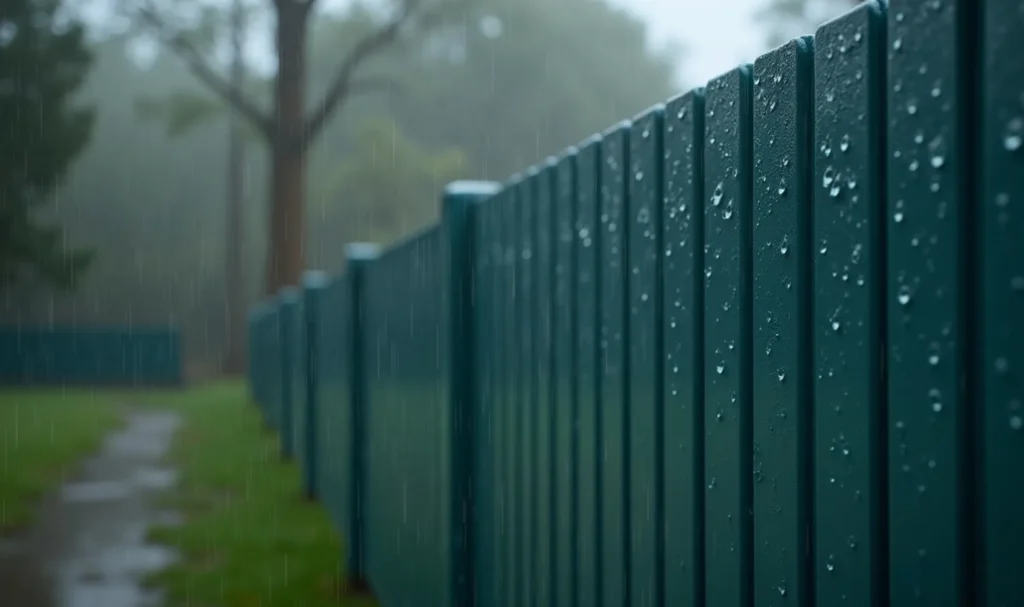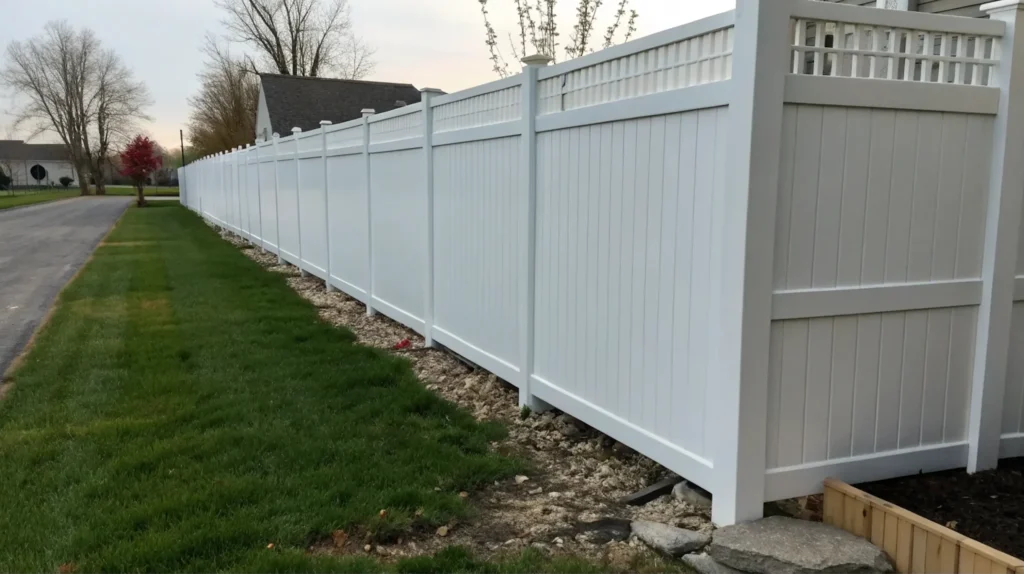SEO Meta Description: Upgrading your yard? Discover how a vinyl fence provides durable, stylish, and maintenance-free fencing solutions that enhance your property.
Introduction to Vinyl Fence
When it comes to enhancing your home's exterior, choosing the right type of fencing can make all the difference. Among various options available, vinyl fence has gained popularity. But what makes it stand out? This fencing style combines durability, aesthetics, and low maintenance, making it an attractive option for homeowners. With an array of colors and styles, a vinyl fence can boost the appearance and value of your property while offering practical benefits. In this comprehensive guide, we will explore everything about vinyl fences—you'll be well-equipped to make informed choices for your property.
What is a Vinyl Fence?
A vinyl fence is made from polyvinyl chloride (PVC) or a similar synthetic material, comprising various additives to improve longevity and overall performance. Unlike wood fences, which tend to absorb moisture and succumb to rot over time, vinyl fences do not warp, fade, or deteriorate easily. This resistance to weathering makes them an appealing option for locations with varying climates. Additionally, vinyl fences come in various colors and styles, allowing homeowners to select a design that complements their property.
Benefits of a Vinyl Fence
Opting for a vinyl fence has several significant advantages.
- Durability: Vinyl fences are built to last. They are resistant to chipping, cracking, and fading, ensuring that your fence doesn’t become an eyesore over time.
- Low Maintenance: Unlike wood, vinyl doesn’t need to be painted or stained regularly. You can clean it with soap and water—sometimes a simple garden hose is all it takes.
- Variety of Styles: Vinyl fencing comes in an impressive range of styles and colors. Whether you’re looking for a classic white picket fence or a solid privacy fence, the options are virtually limitless.
- Cost-Effectiveness: While the initial cost of a vinyl fence may be higher than wood, the long-term savings due to low maintenance and replacement costs make it a wise investment.
- Eco-Friendly: Many vinyl fences are made from recycled materials and are themselves recyclable, making them an environmentally friendly choice.
In conclusion, the benefits of a vinyl fence extend beyond aesthetics; they promote long-term savings and environmental sustainability.
Types of Vinyl Fences
When considering a vinyl fence, knowing the different types can help you choose the best fit for your needs. Here are the most common types:
Privacy Vinyl Fences
Privacy vinyl fences are designed to create secluded spaces. They typically feature solid panels without gaps, allowing homeowners to enjoy their yards without the worry of prying eyes.
Picket Vinyl Fences
Picket fences have a traditional appeal. These fences often have spaced pickets, providing a charming look while marking boundaries without complete enclosure. They are perfect for front yards and garden areas.
Ranch Rail Vinyl Fences
Ranch rail vinyl fences are often seen on larger properties, such as farms or estates. They usually consist of wide rails and an open design, providing an attractive, rustic farm-like look while maintaining visibility.
Understanding the various types of vinyl fencing can help you identify what suits your needs best.
Vinyl Fence vs. Wood Fence
One of the most frequently debated topics in fencing is whether to choose vinyl or wood. Here are some critical differences to consider:
- Durability: Vinyl fences typically last longer than wood fences. Whereas wood is prone to rot, warping, and pest infestations, vinyl is inherently designed to withstand the elements.
- Maintenance: Wood fences require ongoing care, such as staining, sealing, or painting, to keep them looking their best. Vinyl simply requires occasional cleaning.
- Cost: The initial cost of vinyl may be higher, but in the long run, you'll save time and money with less maintenance and replacement needs.
- Aesthetics: While wood is often praised for its natural beauty, vinyl comes in various styles and colors, which means you can find an option that suits your home beautifully.
The choice between vinyl and wood largely depends on your personal preferences, budget, and the climate in your area.
Vinyl Fence vs. Chain-Link Fence
Chain-link fences have long been a budget-friendly option, but how do they compare to vinyl?
- Security: While chain-link fences provide visibility and security, a vinyl fence offers a more solid barrier, enhancing privacy and preventing intruders.
- Appearance: Vinyl fences tend to look more appealing than stark chain-link ones. With vinyl, you can choose a style and color that blends with your property better.
- Durability: Vinyl is less likely to tarnish or rust compared to chain-link, often resulting in a longer lifespan.
When considering aesthetics and privacy, vinyl fences outshine chain-link options.
Durability of Vinyl Fences
A significant advantage of a vinyl fence is its durability. Vinyl is engineered to withstand harsh weather conditions, including heavy rain, snow, and high winds. Unlike wood, vinyl doesn’t suffer from issues like splintering, rotting, or warping. Additionally, vinyl fences are resistant to UV rays, which means they won’t fade or discolor over time, maintaining their beauty for years.
Moreover, many vinyl manufacturers offer warranties, showcasing their confidence in the product’s longevity. It’s common to find warranties that last for decades, adding further peace of mind for homeowners.
Maintenance Required for Vinyl Fences
As mentioned, one of the most appealing aspects of a vinyl fence is the minimal maintenance required. They don't need regular treatments such as staining or painting, unlike their wooden counterparts. Instead, the occasional wash-down with soap and water is typically all that’s needed to keep them looking fresh.
It's crucial to remove any accumulated debris to prevent them from becoming stained. Additionally, inspect the fence periodically to ensure that no weeds or plants are growing up against it, as they can affect the fence's integrity over time.
Installation Process of Vinyl Fences
Installing a vinyl fence might seem daunting, but with proper planning and tools, it can be done efficiently.
Tools Required for Installation
To begin with, gather essential tools, including:
- Tape measure
- Level
- Post hole digger
- Concrete mix
- Rubber mallet
- Drill
Step-by-Step Installation Guide
- Plan Your Layout: Determine where you want your fence to go. Mark the corners and line using stakes and string.
- Dig Post Holes: Use a post hole digger to make the holes deep enough for the posts—generally below the frost line.
- Install Fiberglass or Vinyl Fence Posts: Place the posts into the holes and add concrete for stability.
- Attach Panels: Once the posts are secure, attach the vinyl panels. Use brackets and screws to ensure everything stays in place.
- Finish with Caps: Most vinyl posts come with caps, which you can seal on top to complete the look.
It’s always recommended to read the manufacturer’s instructions, as each product may have specific requirements.
Cost Considerations for Vinyl Fences
The vinyl fence price can vary considerably based on several factors, including design, height, and quality. On average, homeowners might spend between $20 to $40 per linear foot, including materials and installation.
While the initial investment may seem steep, consider the lifespan—most vinyl fences can last 20 to 30 years or more. This longevity, coupled with low maintenance costs, makes vinyl fencing a cost-effective option in the long term.
Additionally, remember to budget for local permits and any potential landscaping or grading work that may be needed before installation.
Design Options for Vinyl Fences
The options for vinyl fences are truly endless. From varied heights to different panel designs, homeowners can customize their fencing to perfectly suit their property. Some popular styles include:
- Solid Panels for privacy
- Picket Designs for a classic look
- Lattice Topped Fences for added flair
Choosing a style that harmonizes with your home’s architecture will enhance curb appeal and possibly increase your property value.
Common Vinyl Fence Colors and Styles
While white is the most common color for vinyl fences, many manufacturers offer a range of colors and textures to choose from. These include beige, gray, and even wood-like finishes that create a warm, natural appearance.
When selecting a color, consider how it will blend with your landscape and home exterior. Light colors can help brighten up your yard, while darker shades may create a more dramatic and modern look.
Environmental Impact of Vinyl Fences
Vinyl is made from PVC (polyvinyl chloride), which is a recyclable material. When a vinyl fence reaches the end of its lifespan, it can often be repurposed or recycled, leading to less waste in landfills.
Moreover, many vinyl manufacturers are now producing eco-friendlier variants. These products utilize recycled materials for manufacturing, lowering their overall environmental footprint. If environmentally-conscious purchases are important to you, it’s worth researching the source and manufacturing practices of the vinyl you choose.
Safety Considerations for Vinyl Fences
Choosing the right fencing isn’t just about aesthetics but also safety. Vinyl fences are smooth, which means there's no risk of splinters from broken wood. Their sturdy nature can prevent accidental collapses or falls, making them an excellent choice for families with children and pets.
When selecting your vinyl fence, it's essential to use designs that don’t have sharp edges or protrusions, ensuring a safe environment for everyone around.
DIY vs. Professional Installation
Many homeowners consider taking the DIY approach for cost savings, while others prefer professional installation for peace of mind. While DIY can save money, it requires time, effort, and some level of skill.
If you opt for a professional, you’ll enjoy:
- Correction of any installation mistakes
- Understanding of local regulations or permits
- Often longer warranties provided by installers
Weigh the pros and cons based on your comfort level, budget, and time constraints when deciding.
Frequently Asked Questions (FAQs)
What is the life expectancy of a vinyl fence?
Most vinyl fences can last 20 to 30 years with proper maintenance. However, many manufacturers offer lifetime warranties, signifying their commitment to quality.
Can I paint my vinyl fence?
Painting a vinyl fence isn't generally necessary or recommended. If you wish to alter its color, it’s better to replace it with a different color option. The risk of paint peeling is high.
Are vinyl fences suitable for all weather conditions?
Absolutely! Vinyl is engineered to withstand extreme temperatures and difficult weather conditions, from intense sunlight to heavy snow.
How do I clean my vinyl fence?
A simple mixture of soap and water usually does the trick. For tougher stains, use a mix of baking soda and vinegar, scrubbing the affected area gently.
Do vinyl fences fade in sunlight?
While traditional vinyl can fade, most modern vinyl fences are UV resistant. Opting for quality materials can help ensure your fence looks great for years.
Are vinyl fences more expensive than wood?
Yes, the initial cost of vinyl is generally higher. However, when considering longevity and maintenance costs, vinyl fencing proves to be cost-effective in the long run.
Conclusion
Choosing a vinyl fence is about enhancing your home’s beauty while investing in long-term durability and low maintenance. With a variety of styles, colors, and practical benefits, vinyl fencing stands out as an excellent choice for residential properties. Whether you're looking for privacy, security, or simply a lovely border for your garden, a vinyl fence can fulfill those needs beautifully.
Remember to evaluate your needs and conduct thorough research or consult professionals to be fully equipped as you embark on your fencing journey. With the right vinyl fence, you’re not just adding boundaries; you’re increasing the value of your home, creating a welcoming space, and ensuring safety for years to come.



